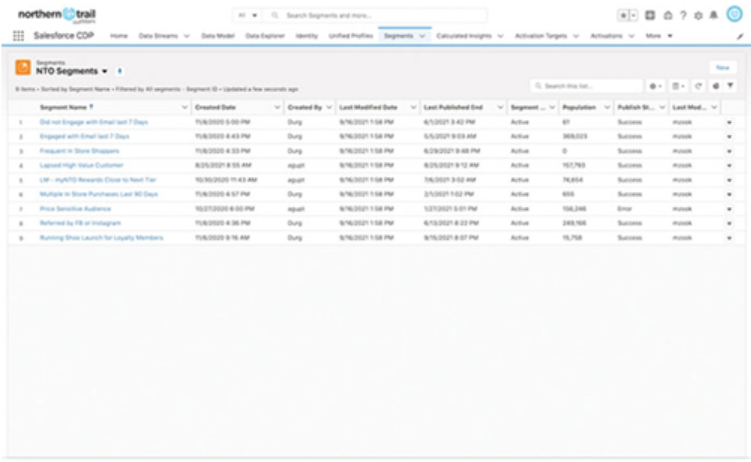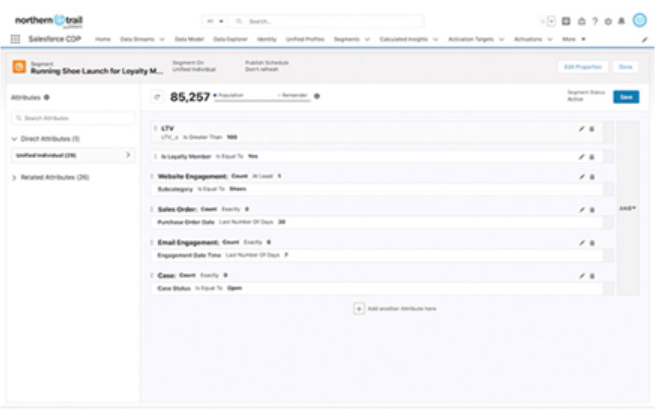Segmentation involves identifying particular characteristics or actions that are common among a subset of profiles in your customer database to create distinct groups for targeted marketing purposes. For instance, in an email campaign titled “Did you forget to buy your t-shirt?”, you might want to target individuals who have recently searched for t-shirts but haven’t made a purchase in the last 30 days. By employing various segments, you can tailor your marketing efforts to different audiences, resulting in a more personalized and effective marketing experience.
With your customer data, you would want to create segments for different use cases. Since you have accumulated the data from different sources, and stitched the customer profiles into unique profiles, now, you will be able to segment the customer based on business needs.
CDPs offer segmentation tools that allow marketers to define and create customer segments based on specific criteria and attributes. These tools typically provide a user-friendly interface to set segmentation rules and apply filters to segment the customer base effectively. CDPs enable the creation of dynamic segments that automatically update as customer data changes or new data is added. This ensures that segments remain current and aligned with customer behaviors and preferences.
Creating a segment will differ from one CDP platform to another. The best way to learn it is to check the documentation for that particular vendor.
We will take a look at a hypothetical example and use Salesforce CDP as the CDP vendor. Let us now see how a Salesforce admin will create segments in Salesforce CDP.
Bianca, an NTO marketer, accesses Salesforce and begins working with the Salesforce CDP app. In the Segment tab (see Figure 5.9), she examines the existing segments within her organization.

Figure 5.10: Segments tab in Salesforce CDP (Source: https://admin.salesforce.com/blog/2022/segment-your-audiences-with-salesforce-cdp)
She creates a new segment by selecting the New option and assigning a name to it (see Figure 5.10). Bianca ensures that her unified customer data serves as the data source for this segment. She then sets the frequency at which the segment should be published or updated and saves her settings.

Figure 5.11: Create a new segment in Salesforce CDP (Source: https://admin.salesforce.com/blog/2022/segment-your-audiences-with-salesforce-cdp)
Bianca can now apply filters using any attribute from her unified data. For the shoe launch, she establishes specific criteria for targeting customers. She wants to focus on NTO loyalty program members with a lifetime value exceeding $100, who have also browsed shoes on the NTO website at least once.
There are certain customers that Bianca wants to exclude from the segment. She specifies that customers who made a purchase within the last 30 days or have an open case should not be included. Additionally, any customers who received an email engagement in the past 7 days should be excluded, considering that the segment will be used for an email campaign by NTO marketers.
She drags the desired attribute onto the canvas, defines the criteria, and proceeds to the next filter. With just a few clicks, she sets up all the necessary filters.
Bianca can observe the impact on the audience size in real-time. Initially, the segment consisted of over 21 million customers, but now it has been refined to just over 85,000 customers (see Figure 5.11). This significant reduction indicates that these customers are highly relevant to the NTO sneaker launch and are more likely to make a purchase.

Figure 5.12: A created segment shows the target customer count (source- https://admin.salesforce.com/blog/2022/segment-your-audiences-with-salesforce-cdp)
Different CDP tools offer different ways for segmentation. The point here is that you have to create the customer segments before proceeding toward activating the data.

